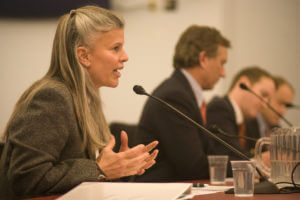- December 03, 2019
- By Sala Levin ’10
If Jamie Rappaport Clark’s career has a recurring motif, it might well be the peregrine falcon: As an undergraduate, Clark released the hulking bird of prey back into the wild, and as director of the U.S. Fish and Wildlife Service 20 years later, she spearheaded their removal from the endangered species list.
Today, Clark M.S. ’82 is president and CEO of Defenders of Wildlife, an organization dedicated to wildlife and habitat conservation in North America. Her decades working with critters big and small and the places they call home—including advocating in front of Congress for their protection—have been a change from her childhood plans to be a veterinarian.
After graduating from Towson University with a degree in wildlife biology, Clark came to the University of Maryland as the only woman in her graduate class studying wildlife ecology. “I always thought I would be out in the field saving wildlife,” she says.
For a while, she was. As a wildlife biologist with the Army and then with the U.S. Fish and Wildlife Service (USFWS), Clark worked across the country to protect spotted owls, gray wolves, grizzly bears and other animals. “I had some really great opportunities to work with some pretty iconic wildlife,” she says.

Married to another wildlife biologist (the couple eloped on Matagorda Island National Wildlife Refuge off the coast of Texas), Clark eventually left the field and settled into policy work, rising to become director of USFWS, a Senate-confirmed presidential appointment, during President Bill Clinton’s administration. While there, she oversaw the addition of more than 2 million acres and 27 new refuges to the National Wildlife Refuge System, as well as the recovery of endangered species like the bald eagle and Aleutian Canada goose, and management of migratory birds nationwide. She also led the agency through the passage of 1997’s landmark National Wildlife Refuge System Improvement Act, which established wildlife conservation as the primary purpose of all wildlife refuges.
“She’s got tremendous credibility because she’s a career biologist,” says Don Barry, whose career included serving as an assistant secretary at the Department of the Interior and a period at Defenders of Wildlife. “Every once in a while you see someone go into conservation work who really doesn’t have a background” in the nitty-gritty of animal science and conservation laws, “but Jamie knows all that stuff cold.”
In 2001, the new administration meant a professional move for Clark, who ultimately landed at Defenders of Wildlife. In her current role, Clark pushes for wildlife conservation on the ground, with federal agencies and on Capitol Hill. As the effects of climate change take hold—among them loss of snow cover for animals who depend on it, shifting migratory patterns and decreasing food supply—legislative support for wildlife protection grows ever more critical, she says. She points to the Baltimore oriole as a beloved local bird that, due to loss of habitat and climate change, may not find a home in Maryland within the next 50 years.
It’s not just wildlife counting on Clark; her 20-year-old son Carson, named after environmentalist Rachel Carson, “has great expectations that I’m going to solve this crisis before he has to deal with it,” she says.
